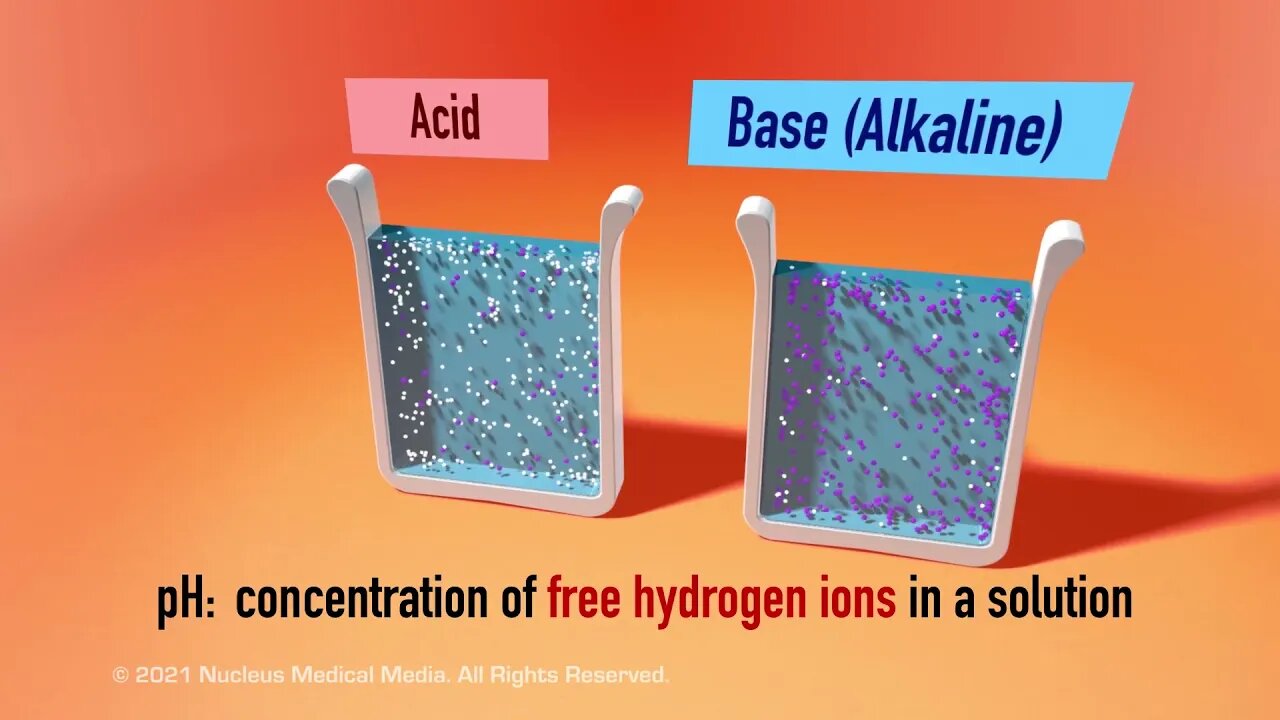Premium Only Content

For Employees of hospitals, schools, universities and libraries: download up to 8 FREE medical animations from Nucleus by signing up for a free trial at: http://nmal.nucleusmedicalmedia.com/biology_youtube
#pH #HydrogenIons #HydroxideIons
SCIENCE ANIMATION TRANSCRIPT: Now that we've discussed acids and bases, let's talk about pH. The H in pH stands for hydrogen. pH is a measure of the concentration of free hydrogen ions in a solution. It tells us whether the solute in a solution is an acid or a base. Sometimes a base is referred to as being alkaline. To measure how acidic or basic a substance is, scientists use the pH scale, numbered from 1 to 14. The pH scale is an inverse scale of the concentration of hydrogen ions in a solution. The more hydrogen ions it contains, the lower its pH number and the stronger an acid it is. In contrast, the more hydroxide ions a solution has, the higher its pH number and the more basic or alkaline it is. Water is pH-neutral because it contains equal numbers of hydrogen and hydroxide ions. So water is right in the middle of the scale at a neutral pH of seven. Each whole number on the pH scale represents an exponential difference in value. This means that each whole number decrease in pH represents a 10 times increase in hydrogen ion concentration. For example, coffee has a pH of 5. So from a pH of 7 to a pH of 5, there is 10x10 or a 100-fold increase in hydrogen ion concentration compared to neutral water. As you can see, coffee is 100 times more acidic than water. This also means that coffee is 100 times less alkaline than water because it has a 100-fold decrease in hydroxide ion concentration. Baking soda is an example of a base with a pH of nine. It has a 100-fold decrease in hydrogen ion concentration compared to neutral water. However, it also has a 100 fold increase in hydroxide ion concentration. So baking soda is a hundred times more basic or alkaline than water. To function properly, biological processes in the human body require fluids with a pH in the range of approximately 6.5 to 7.5. For example, the normal pH of blood is 7.4. If acids or bases in the blood lower or raise the pH too much, a person could become sick or die. One way the body controls pH is through the use of different buffers. Buffers are substances that neutralize other acids and bases in solutions such as blood to prevent dramatic swings in pH. In summary, pH is a measure of the concentration of free hydrogen ions in a solution. A pH scale is an inverse scale of hydrogen ion concentration from 1 to 14. If the hydrogen ion and hydroxide ion concentrations are the same, the solution is pH-neutral. A pH of seven on the pH scale is neutral. Pure water has a pH of seven. Acids have a pH of less than seven and bases have a pH of greater than seven. The closer to seven a solution is, the weaker the acid or base. The farther away from seven a solution is, the stronger the acid or base. A buffer is a weak acid or base that reacts with a strong acid or base to prevent large changes in pH.
NSV16024
-
 LIVE
LIVE
ItsLancOfficial
3 hours agoWE LIVE 🔴WE LIVE 🔴 SUNDAY SUNDAYS!!!!!!! TARKOV
244 watching -
 LIVE
LIVE
EricJohnPizzaArtist
6 days agoAwesome Sauce PIZZA ART LIVE Ep. #59: Are You Ready for some FOOTBALL with GameOn!
106 watching -
 1:21:43
1:21:43
Jake Shields' Fight Back Podcast
9 hours agoJake Shields and Paul Miller!
24.7K53 -
 LIVE
LIVE
TRAGIKxGHOST
26 minutes agoTrying to get SCARED tonight! | Are You SCARED!? | Screams Beyond Midnight | Grab a Snack
31 watching -
 LIVE
LIVE
StuffCentral
2 hours agoI'm baaack (no you can't play with me.. unless you a healer)
37 watching -
 2:25:11
2:25:11
TheSaltyCracker
3 hours agoTrump Is Not Dead ReEEeStream 8-31-25
49.2K81 -
 LIVE
LIVE
THOUGHTCAST With Jeff D.
1 hour agoLabor Day Weekend FORTNITE With THOUGHTCAST Jeff & the squad
74 watching -

Rallied
4 hours ago $2.24 earnedSolo Challenges All Day
26.5K1 -
 LIVE
LIVE
iCheapshot
4 hours agoCall of Duty: Black Ops Campaign
36 watching -
 4:39:16
4:39:16
Meisters of Madness
5 hours agoMadness in a Pod
6891